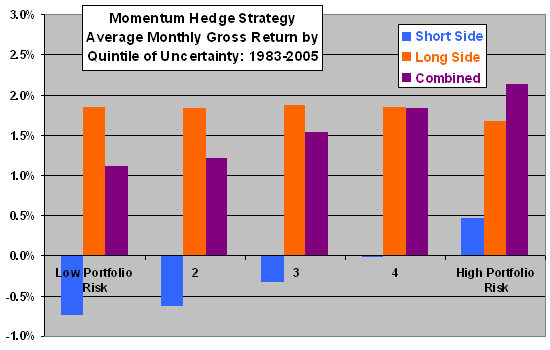Do measures of momentum portfolio risk affect returns and return components? In their April 2010 paper entitled “Asymmetric Momentum Effects Under Uncertainty”, David Kelsey, Roman Kozhan and Wei Pang investigate how the profitability of a momentum hedge strategy varies with portfolio firm-level risk. They use six measures of firm-level risk: (1) size (market capitalization); (2) age (since listing); (3) number of analysts following; (4) dispersion of analyst earnings forecasts; (5) realized volatility of weekly stock returns over the past year; and, (6) cash flow volatility. Using stock return, firm fundamentals and analyst earnings forecast data for a broad sample of U.S. stocks spanning 1983-2006, they conclude that:
- Momentum hedge portfolio gross return generally increases with portfolio firm-level risk for all of the six risk measures.
- Variation in return to the short side of the hedge portfolio drives the variation in momentum returns with portfolio firm-level risk (see the chart below).
- Investors may be able to tune momentum portfolio performance by weighting the long and short sides differently according to the level of portfolio risk.
The following chart, constructed from data in the paper, compares average monthly gross returns for the short side, long side and combined sides of equally weighted hedge portfolios formed from monthly double quintile sorts of the broad sample of U.S. stocks over the entire sample period. The first sort is on past 12-month return. The second sort is on one of the six measures of portfolio risk. These sorts produce 30 hedge portfolios (six measures of risk times five quintiles of uncertainty for each measure) that are long past winners and short past losers, reformed monthly. The chart presents the average returns across the six measures by quintile of risk.
Results show that the contribution of past winners to momentum hedge portfolios is insensitive to portfolio risk, but that the contribution of past losers increases from negative to positive as risk increases. Investors may want to vary portfolio winner-loser composition according to level of portfolio risk.

This study ignores trading frictions and the way in which trading frictions may vary with level of portfolio risk. Such variation might offset the effects of portfolio risk on gross return.
In summary, evidence suggests that investors employing hedge momentum strategies may want to adjust the level of hedging (long past winners versus short past losers) according to portfolio risk level.